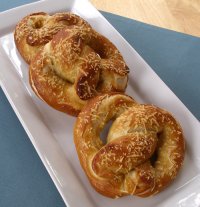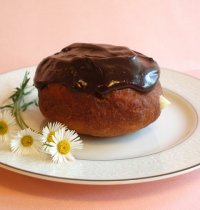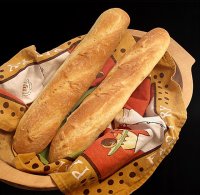Tiered Crown Pavlova (Meringue) Cake
16199 views| 2 comments
Copyright © 2000 Sarah Phillips CraftyBaking.com All rights reserved.
 Commercial, also known as cultured yeast or baker's yeast is a fermentation agent that belongs to the Saccharomyces cerevisiae species and is actually a member of the mushroom family. It is a biological leavening agent that posses the basic attributes of all living things. Its role is to create the bread fermentation process, which produces carbon dioxide gas, which in turn creates the internal structure of the dough, causing it to rise.
Commercial, also known as cultured yeast or baker's yeast is a fermentation agent that belongs to the Saccharomyces cerevisiae species and is actually a member of the mushroom family. It is a biological leavening agent that posses the basic attributes of all living things. Its role is to create the bread fermentation process, which produces carbon dioxide gas, which in turn creates the internal structure of the dough, causing it to rise.
The proper temperature of the liquids used to proof (make sure it is still alive) commercial yeast in, is essential.
SARAH SAYS: If the recipe calls for milk, I typically substitute a portion of it with water to proof my yeast in.
YEAST SUBSTITUTIONS: Yeast types can be substituted according to the following standard formula:
100 percent fresh yeast = 40 to 50 percent active dry yeast = 33 percent instant yeast
To convert cake yeast to instant yeast:
For 1 packed tablespoon cake yeast use 2 teaspoons instant yeast or 2 1/4 teaspoons active dry
OR
To convert recipes calling for instant yeast to active dry yeast: Use 1.25 times the weight; or, for 1 teaspoon instant yeast, use about 1 1/4 teaspoons active dry yeast
OR
To convert recipes calling for active dry yeast to instant yeast: Use 0.67 times the weight; or, for 1 teaspoons active dry yeast, use 3/4 teaspoon instant yeast
OR
To convert recipes calling for fresh compressed yeast to instant yeast: Use 0.32 times the weight; or, for 1 packed Tablespoon (21 grams) fresh yeast, use 2 teaspoons instant yeast
NOTE: Equivalencies may vary. Follow the package instructions. Adjust the water or liquid temperature and how the yeast is added to the recipe accordingly when making substitutions.
MORE INFORMATION
It was discovered in a French laboratory in the mid-1800s by Louis Pasteur then, and became commercially available at the end of that century. Yeast breads made from packaged yeast tend to be the smooth looking loaves typically with a fine, even grain (air holes) on the inside. Examples are white and whole wheat loaves, but also includes dinner rolls, yeasted coffee cakes, bagels, pizza crusts, and some pancakes and waffles.
Commercial yeast, readily available in stores, comes in a dehydrated form or fresh. It is made by food companies, such as Fleischmann's Yeast, SAF or Red Star, from one species of yeast from the family Saccharomyces cerevisae - sacchar meaning sugar loving or feeding, myces meaning mold, and cerevisae being a word that was once used for beer. (Packaged yeast is the same species used when making alcoholic beverages and flavor extracts.) To activate it, packaged yeast needs moisture, food, and the proper environment.
Dry yeast: The most popular type, such as active dry yeast, is available in a dehydrated form in premeasured packages in the baking isle.
 1. Active Dry Yeast: is called active to distinguish it from Nutritional or Brewer's Yeast which is also dry and NOT the same thing.
1. Active Dry Yeast: is called active to distinguish it from Nutritional or Brewer's Yeast which is also dry and NOT the same thing.
Active Dry Yeast is the most commonly available and most widely used kind of yeast for home bakers, but Instant Active Dry Yeast is quickly becoming more popular in recipes. It is reliable and predictable and has been grown for flavor and speed of growth. It also adds a nice yeasty flavor to the bread. This yeast is available in 1/4-oz. packets, by the jar in grocery stores, or in bulk at natural food stores.
If you open up a package of Active Dry Yeast, also known as "baker’s yeast", sprinkle some out, you’ll see tiny brownish grains. These are clumps of dehydrated, pure yeast cells that has been air dried into dormant granules. In each yeast envelope, there are thousands of living plant-like microorganisms, which are finely ground and absorb moisture quickly to convert the flour's starches and sugar into carbon dioxide.
 2. Instant Active Dry Yeast (Also known as RapidRise or Quick-Rise brand names and Bread Machine Yeast): A newly developed strain of yeast that can be mixed with the dry ingredients, as opposed to being proofed (dissolved) and requires only one rise. Instant Yeast combines the qualities of of both Active and Fresh Yeast -- the first one known for its convenience and the latter for its potency. These types of yeast also contain ascorbic acid resulting in increased loaf volumes.
2. Instant Active Dry Yeast (Also known as RapidRise or Quick-Rise brand names and Bread Machine Yeast): A newly developed strain of yeast that can be mixed with the dry ingredients, as opposed to being proofed (dissolved) and requires only one rise. Instant Yeast combines the qualities of of both Active and Fresh Yeast -- the first one known for its convenience and the latter for its potency. These types of yeast also contain ascorbic acid resulting in increased loaf volumes.
The particle size of Instant Active Dry Yeasts are finely granulated to allow complete hydration of the yeast cells during the mixing process. As a result, instant yeast becomes active the "instant" it contacts moisture. (Some bakers like to proof their instant yeast anyway -- dissolving the yeast in warm water and letting it stand until it begins to bubble -- to assure themselves that the yeast is still fresh, but is not necessary).
While Instant Active Dry Yeast is especially suited to the types of breads typically made in bread machines, it also works for general hand baking. However, avoid rapid rise yeast when you want to develop flavor in the bread through long rising times - according to some bakers, the flavor of the bread does not develop and the texture may suffer because of a fast rise. However, I generally prefer to use Active Dry and Cake Yeast for my yeasted dough recipes.
Bread Machine Yeast, Instant Active Dry Yeast or Rapid Rise: "Bread machine yeast," also known as "instant" yeast, requires no proofing. It becomes active the "instant" it contacts the liquid ingredients. It is a special strain of yeast and is designed to disperse more thoroughly through the dough during mixing and kneading, well suited to bread machines. You can toss it in with all the other ingredients and press the start button. However, always use what is recommended in the recipe. 2-1/4 teaspoons Bread Machine Yeast is equivalent to one envelope dry yeast. If using fast acting or quick rise yeast on the basic settings of a bread machine, use 1/2 teaspoon per cup of flour. At high altitudes, use one-quarter teaspoon yeast per cup of bread flour.
It is still possible to use the more traditional active dry yeast, but you must proof it in the bucket of the bread machine with the water in the recipe before adding the other ingredients and pressing start. (This poses a problem if you want to use the bread machine's timer). The temperature of the water or liquid in the recipe used has been to be adjusted to 105 - 115 degrees F or as recommended by the manufacturer, as measured with an Instant Read Thermometer.
SAF Products package (SAF Gold) a type of instant yeast called osmotolerant. It is perfect to use in very sweet or very acidic doughs, that normally slow down regular yeast strains.
Fresh or Compressed Yeast, Cake Yeast: Cake yeast comes in the form of small, soft and crumbly squares in a starch medium, found in the refrigerated case in the store, but can be hard to find. It gives a wonderful yeasty flavor to the bread recipe. (If frozen, thaw the cakes in the refrigerator before activating). It is considered to be potent and it imparts a great flavor to the final loaf. It can either be dissolved in water first or crumbled into the dry ingredients. This yeast is especially well suited to long rises and sponges.
16199 views| 2 comments
9963 views| 0 comments
8633 views| 0 comments